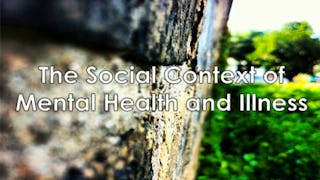Public Mental Health is the application of the principles of medicine and social science to prevent the occurrence of mental and behavioral disorders and to promote mental health of the population. This course illustrates the principles of public health applied to depressive disorder, including principles of epidemiology, transcultural psychiatry, health services research, and prevention. It is predicted that by 2020 depressive disorder will be the most important cause of disease burden in the entire world! Every human being suffers from feeling depressed at some point or other, but only about one fifth of the population will experience an episode of depressive disorder over the course of their lives. This course illuminates the public health approach to disease, and the particular complexities of applying this approach to mental disorders, using depression as the exemplar.



Major Depression in the Population: A Public Health Approach



Instructors: William Eaton, PhD
42,037 already enrolled
Included with 
(381 reviews)
Skills you'll gain
Details to know

Add to your LinkedIn profile
6 assignments
See how employees at top companies are mastering in-demand skills


Earn a career certificate
Add this credential to your LinkedIn profile, resume, or CV
Share it on social media and in your performance review

There are 8 modules in this course
Welcome to Major Depression in the Population: A Public Health Approach. Let's take a few moments to introduce the course before we dive into our first lessons.
What's included
1 video2 readings
This week, we will be focusing on the definition of major depression and the methods that we use for measuring its effect on populations.
What's included
5 videos1 assignment1 discussion prompt
This week we will be covering depression from a global public health perspective.
What's included
4 videos1 assignment1 discussion prompt
This week we take advantage of what we know about major depressive disorder to examine major epidemiologic research designs, including the case control design, the cohort design, and the study of diseases in time and space.
What's included
5 videos1 assignment1 discussion prompt
This week the focus is on possible causes for depressive disorder, including inheritance, stress, social life, work life, and the evolution of modern living.
What's included
5 videos1 assignment1 discussion prompt
Choice 1: You are the coordinator of an international nutrition program in refugee camps, including a refugee camp in Tanzania. Most of the refugees in this camp have fled violence from the Democratic Republic of the Congo, and the size of the camp is increasing because of the intensification of armed violence there. The nutrition organization that you have been working for has been implementing programs to promote breastfeeding, and appropriate infant and young child feeding practices. You have been told that program staff are facing difficulties, and you decide to visit the site to see for yourself what is going on. In your meeting with some of the community health workers who are implementing the program, you hear of women living in very challenging circumstances. A group of women seems to be very tired and have lost the energy to engage with daily routines. You suspect that mental health may play a role, and decide to ask further questions and write a report about this to your organization’s headquarters. | Choice 2: A young entrepreneur from Oklahoma named Rodney Johnson created a household cleaning product made from byproducts of the corn industry. This product, called Solvit, is very good at cleaning up grease and dirt, and was more effective than many other well-known products such as Mr. Clean, Fantastik, and Lysol. Mr. Johnson started marketing the product in 1992 at stores in his native Oklahoma, and also on the World Wide Web. Twenty years later this product is the most widely used cleaning agent in North America, although it still has not been introduced in several states. In 2012 Consumer Reports magazine determined that the product contained solvents that might cause depressive disorder. It asked the Consumer Products Safety Commission to ban the product. The Institute of Medicine was asked for its advice. The IOM learned that you had taken this course and has asked you to consult on epidemiologic evidence and methods that might support the claim that Solvit produces depressive disorder.
What's included
2 peer reviews
In this module, we discuss unmet need for treatment and treatment seeking and present a public health view of depression treatment.
What's included
4 videos2 assignments2 discussion prompts
What's included
1 peer review
Instructors



Offered by
Recommended if you're interested in Public Health


American Psychological Association


University of Toronto


Universiteit Leiden


The University of Sydney
Why people choose Coursera for their career




Learner reviews
381 reviews
- 5 stars
78.21%
- 4 stars
17.58%
- 3 stars
2.62%
- 2 stars
1.04%
- 1 star
0.52%
Showing 3 of 381
Reviewed on Jun 13, 2020
Very good course. I learned a lot about depression as well as about epidemiology.
Reviewed on Nov 15, 2021
It was an extremely eye-opening corse. The professors explained everything really well. I highly recommend this course.
Reviewed on Oct 11, 2020
Thanks the course was very comprehensive and well structured. Would recommend this to my network .
New to Public Health? Start here.

Open new doors with Coursera Plus
Unlimited access to 10,000+ world-class courses, hands-on projects, and job-ready certificate programs - all included in your subscription
Advance your career with an online degree
Earn a degree from world-class universities - 100% online
Join over 3,400 global companies that choose Coursera for Business
Upskill your employees to excel in the digital economy
Frequently asked questions
This course is NOT intended for people who are seeking help or treatment for their own symptoms of depression. We are not in a position to offer clinical advice about specific symptoms that you or a loved one might be experiencing. If you or someone you know are experiencing symptoms of depression, we urge you to seek help from a medical professional or some other trusted source of assistance.
Access to lectures and assignments depends on your type of enrollment. If you take a course in audit mode, you will be able to see most course materials for free. To access graded assignments and to earn a Certificate, you will need to purchase the Certificate experience, during or after your audit. If you don't see the audit option:
The course may not offer an audit option. You can try a Free Trial instead, or apply for Financial Aid.
The course may offer 'Full Course, No Certificate' instead. This option lets you see all course materials, submit required assessments, and get a final grade. This also means that you will not be able to purchase a Certificate experience.
When you purchase a Certificate you get access to all course materials, including graded assignments. Upon completing the course, your electronic Certificate will be added to your Accomplishments page - from there, you can print your Certificate or add it to your LinkedIn profile. If you only want to read and view the course content, you can audit the course for free.
More questions
Financial aid available,

